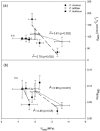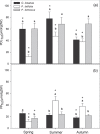Seasonal and daily variations in primary and secondary metabolism of three maquis shrubs unveil different adaptive responses to Mediterranean climate
- PMID: 32467757
- PMCID: PMC7245392
- DOI: 10.1093/conphys/coz070
Seasonal and daily variations in primary and secondary metabolism of three maquis shrubs unveil different adaptive responses to Mediterranean climate
Abstract
Maquis species play a central role in the maintenance of coastal ecosystems thanks to anatomical, physiological and biochemical features evolved to cope with severe stress conditions. Because the seasonal and daily dynamics of physiological and biochemical traits of maquis species are not fully addressed, we performed a field study on three coexisting Mediterranean shrubs (Pistacia lentiscus L. and Phillyrea latifolia L., evergreen schlerophylls, and Cistus incanus L., semi-deciduous) aiming at detecting the main adaptive differences, on a seasonal and daily basis, in primary and secondary metabolism along with the principal climatic determinants. These species differed in their physiological and biochemical responses especially on a seasonal level. In P. latifolia, a great investment in antioxidant phenylpropanoids contributed to maintain high photosynthetic rates throughout the whole growing season. In C. incanus, high carotenoid content associated with chlorophyll (Chl) regulation alleviated oxidative damage during the hot and dry summers and help recover photosynthesis in autumn. In P. lentiscus, high abscisic acid levels allowed a strict control of stomata, while fine Chla/Chlb regulation concurred to avoid photoinhibition in summer. Temperature resulted the most important climatic factor controlling the physiological and biochemical status of these coexisting shrubs and, thus, in determining plant performances in this Mediterranean coastal habitat.
Keywords: Abscisic acid; Mediterranean climate; coastal dune ecosystems; gas exchange; maquis species; photosynthetic pigments; polyphenols; water relations.
© The Author(s) 2019. Published by Oxford University Press and the Society for Experimental Biology. All rights reserved. For permissions, please e-mail: journals.permissions@oup.com.
Figures











Similar articles
-
Morphological, anatomical and physiological leaf traits of Q. ilex, P. latifolia, P. lentiscus, and M. communis and their response to Mediterranean climate stress factors.Bot Stud. 2013 Dec;54(1):35. doi: 10.1186/1999-3110-54-35. Epub 2013 Sep 17. Bot Stud. 2013. PMID: 28510875 Free PMC article.
-
Responses to changes in Ca2+ supply in two Mediterranean evergreens, Phillyrea latifolia and Pistacia lentiscus, during salinity stress and subsequent relief.Ann Bot. 2008 Oct;102(4):609-22. doi: 10.1093/aob/mcn134. Epub 2008 Aug 13. Ann Bot. 2008. PMID: 18701601 Free PMC article.
-
Study of functional and physiological response of co-occurring shrub species to the Mediterranean climate.Saudi J Biol Sci. 2019 Nov;26(7):1668-1675. doi: 10.1016/j.sjbs.2018.08.021. Epub 2018 Aug 23. Saudi J Biol Sci. 2019. PMID: 31762642 Free PMC article.
-
How do Mediterranean shrub species cope with shade? Ecophysiological response to different light intensities.Plant Biol (Stuttg). 2018 Mar;20(2):296-306. doi: 10.1111/plb.12661. Epub 2017 Dec 10. Plant Biol (Stuttg). 2018. PMID: 29125662
-
Low leaf-level response to light and nutrients in Mediterranean evergreen oaks: a conservative resource-use strategy?New Phytol. 2000 Oct;148(1):79-91. doi: 10.1046/j.1469-8137.2000.00737.x. New Phytol. 2000. PMID: 33863045 Review.
Cited by
-
Plant Flavonoids in Mediterranean Species: A Focus on Flavonols as Protective Metabolites under Climate Stress.Plants (Basel). 2022 Jan 10;11(2):172. doi: 10.3390/plants11020172. Plants (Basel). 2022. PMID: 35050060 Free PMC article. Review.
-
Biochemical Composition and Biological Activities of Various Population of Brassica tournefortii Growing Wild in Tunisia.Plants (Basel). 2022 Dec 6;11(23):3393. doi: 10.3390/plants11233393. Plants (Basel). 2022. PMID: 36501432 Free PMC article.
-
Phenolic Compounds from Leaves and Flowers of Hibiscus roseus: Potential Skin Cosmetic Applications of an Under-Investigated Species.Plants (Basel). 2021 Mar 10;10(3):522. doi: 10.3390/plants10030522. Plants (Basel). 2021. PMID: 33802222 Free PMC article.
-
Seasonal Variation in Selected Biochemical Traits in the Leaves of Co-Occurring Invasive and Native Plant Species under Mediterranean Conditions.Plants (Basel). 2022 Apr 26;11(9):1171. doi: 10.3390/plants11091171. Plants (Basel). 2022. PMID: 35567172 Free PMC article.
-
Seasonal and Diurnal Variation in Leaf Phenolics of Three Medicinal Mediterranean Wild Species: What Is the Best Harvesting Moment to Obtain the Richest and the Most Antioxidant Extracts?Molecules. 2020 Feb 20;25(4):956. doi: 10.3390/molecules25040956. Molecules. 2020. PMID: 32093396 Free PMC article.
References
-
- Acosta A, Carranza ML, Izzi CF (2009) Are there habitats that contribute best to plant species diversity in coastal dunes? Biodivers Conservat 18: 1087–1098.
-
- Agati G, Tattini M (2010) Multiple functional roles of flavonoids in photoprotection. New Phytol 186: 786–793. - PubMed
-
- Agati G, Azzarello E, Pollastri S, Tattini M (2012) Flavonoids as antioxidants in plants: location and functional significance. Plant Sci 196: 67–76. - PubMed
-
- Ain-Lhout F, Barradas MD, Zunzunegui M, Rodríguez H, Novo FG, Vargas MA (2004) Seasonal differences in photochemical efficiency and chlorophyll and carotenoid contents in six Mediterranean shrub species under field conditions. Photosynthetica 42: 399–407.
-
- Allen CD, Breshears DD, McDowell NG (2015) On underestimation of global vulnerability to tree mortality and forest die-off from hotter drought in the Anthropocene. Ecosphere 6: 1–55.
LinkOut - more resources
Full Text Sources

